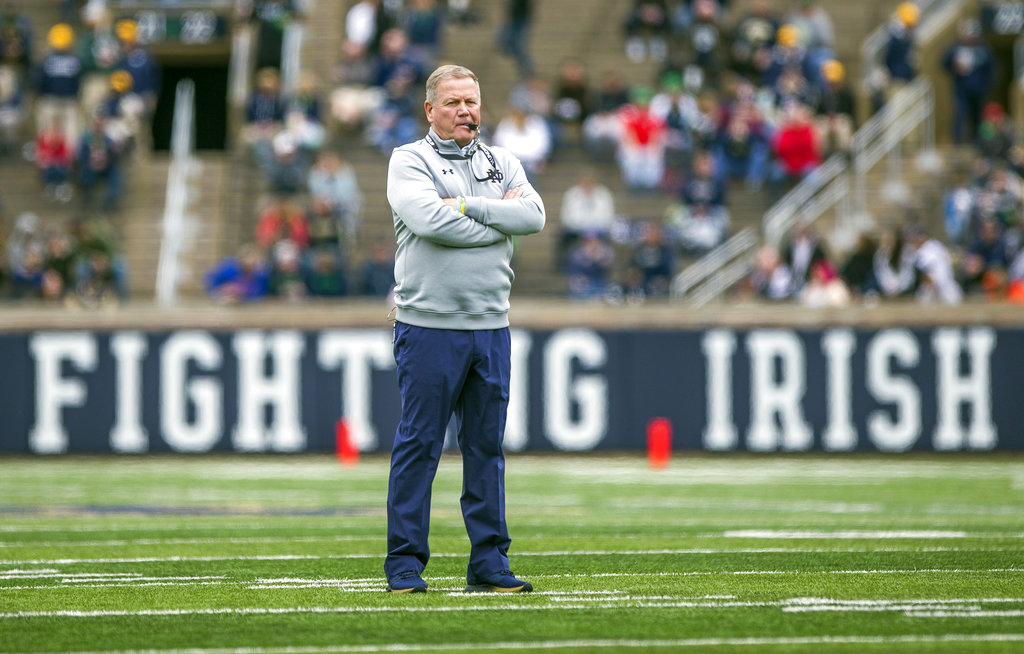Over the course of a season not many traditional stats remain relevant these days. One exception to this would be yards per play differential, a simple yet fairly effective metric on a macro-level. Consider this the antithesis to Michael Bryan’s in-depth advanced preview from earlier this week. Over two years ago in the nascent days of this website I wondered about the Irish 2016 YPP, specifically in regards to the offense which was coming off a school-record mark the previous fall.
You’d think my worry was ridiculous given VanGorder remained started the season as defensive coordinator, but in my defense the Irish offense dropped a large 0.9 YPP by the end of 2016 while the other side of the ball actually improved by 0.2 YPP. Does that mean I was right? I’m not sure about that–VanGorder was fired early in the season after all, the defense did stabilize to some degree, and there was a hurricane game thrown in there to mess with all the numbers.
2017 Recap
Notre Dame’s YPP differential in 2016 did fall to a humbling +0.6 a mark which was hit exactly only one other time since the days of Ara Parseghian. That was during the 5-6 season of 1981. In the big picture, a 4-8 season was a little unflattering compared to the season YPP but most of us know Notre Dame has its own branded mix of bad luck, questionable coaching, and close losses.
A fun fact is that 2016’s +0.6 YPP still would’ve been the best mark for a Notre Dame team between 1999 and 2010. Yes, the opening of the century were filled with many dark days.
Good news, though!
Last season, Notre Dame rebounded and hit +1.0 YPP or better differential for the 9th time since 1984. The 2017 team finished at +1.3 YPP (2nd best of the Kelly era), with a 6.4 YPP offense (2nd best, Kelly era) and 5.1 YPP defense (3-way tie for the 2nd best, Kelly era).
This makes the Fighting Irish a strong 95-16-1 in seasons since 1984 in which they hit at least +1.0 YPP differential.
Can the Irish Make it Back-to-Back?
It’s 2018 and we’re still waiting for the first major bowl victory and consecutive 10+ wins seasons since 1993. Notre Dame is also seeking it’s first back-to-back +1.0 YPP seasons since 1993. Okay, that’s actually not true, they did achieve this feat from 2012 (1.2) to 2013 (1.0) but just barely!
So what could 2018 entail?
Perhaps nothing is more important for YPP than explosive plays on offense and limiting such plays on defense. For me, the biggest questions revolving around this topic is how stable the offense can be versus if the defense can build off the performance from 2017.
The Irish offense has been surprisingly (perhaps) effective finishing 9th, 42nd, 4th, and 14th over the last 4 seasons in IsoPPP, the measure of explosiveness by Football Outsiders. See, I told you the 2016 offense really let the team down! In contrast, the defense has finished 5th, 36th, 57th, and 80th in the same explosiveness measure over the last 4 years.
The IsoPPP formula was tweaked beginning in 2014 but you have to wonder how good the defense will be under Clark Lea if he’s just not VanGorder. From 2014-16 the defense averaged 5.53 YPP on defense while in the Diaco/Elko seasons the defense was a much stouter 5.06 YPP average. To put that in national yardage rankings that’s the difference between finishing roughly 60th or 27th from the 2017 averages.
Top 12 YPP Differential at Notre Dame Since 1964
| YEAR | OFF YPP | DEF YPP | DIFF | RECORD |
|---|---|---|---|---|
| 1966 | 5.5 | 2.9 | +2.6 | 9-0-1 |
| 1973 | 5.7 | 3.3 | +2.4 | 11-0 |
| 1996 | 6.2 | 4.1 | +2.1 | 8-3 |
| 1974 | 5.2 | 3.1 | +2.1 | 10-2 |
| 1970 | 5.4 | 3.5 | +1.9 | 10-1 |
| 1967 | 5.0 | 3.1 | +1.9 | 8-2 |
| 1964 | 5.7 | 3.8 | +1.9 | 9-1 |
| 1992 | 6.4 | 4.6 | +1.8 | 10-1-1 |
| 1977 | 5.3 | 3.5 | +1.8 | 11-1 |
| 1993 | 6.3 | 4.6 | +1.7 | 11-1 |
| 1972 | 5.5 | 3.8 | +1.7 | 8-3 |
| 1969 | 5.2 | 3.5 | +1.7 | 8-2-1 |
Note: Scheduling matters in a not insignificant way for YPP, another tough variable through the years. That’s why 3 of Lou Holtz’ best seasons (1988, 1989, 1991 going a combined 34-4) just miss the cut-off, those schedules were really damn difficult. In contrast, the top dog 1966 team gave up a ridiculous 38 points ALL SEASON although the schedule was quite weak with no bowl game to cap things off. Purdue and Michigan State were top 10 teams while the rest of the schedule went 36-50 and that includes a mediocre talented Army finishing 8-2.
It’s difficult to predict a record based off defensive YPP while looking at past Notre Dame teams–at least going back more than 25 years or so. For one, no Irish defense gave up 5.0 YPP until 1990 (5.5) right around when passing was finally beginning to throw up huge numbers all over the country. Since then, 18 out of the last 27 Irish defenses have surrendered at least 5.0 YPP which is a tremendous stat to show how much the game has changed, and also how Notre Dame’s talent has been lacking.
Can the Irish defense improve by 0.2 YPP and drive the stat under 5.0 for the season? In the post-Holtz era that’s been achieved in 1998, 2001, 2002, 2007 (LOL), and 2012. The ’01 and ’07 seasons saw struggling offenses absolutely torpedo everything for a combined 8-15 record. The other three seasons combined for a very good 31-7 record, with better but still not great offensive play. Those 3 seasons found an average offensive YPP of 5.5, a mark that would’ve fallen in the 70’s nationally in 2017.
QB controversy – check
Major personnel losses – check
Concerning lack of speed – check https://t.co/Tr9tVvOzf0— The Big € Murt (@EMMurtaugh) January 17, 2018
The offense is super tough to predict, even an average passing season would mean around 3,000 yards and about an increase of 1.0 in yards per attempt through the air from last fall. It doesn’t seem crazy to assume an additional 700 yards through the air (53.8 yards per game) from last year because the bar was so ridiculously low.
The bigger question perhaps is if the rushing offense will fall by 700 yards or more. A regression of 700 yards would drop the 2018 rushing offense to a little more productive than the 2015 edition, or in other words still very strong and the second best of the Kelly era. Outside of Wimbush’s terrific legs and Chip Long being a more rushing friendly offensive coordinator most of the indicators point toward a significant decline in ground yardage.
Defense 2018 Prediction
2,650 passing
1,850 rushing
4,500 yards
920 plays
4.89 YPP
Offense Prediction
3,050 passing
2,220 rushing
5,270 yards
905 plays
5.82 YPP
Clearly, this is a high bar for the defense. With these stats they’d be in the conversation as the best Notre Dame defense of the last 20 years, a tick or two better than last year, and probably no worse than the 3rd best defense since the late 90’s. Part of me thinks that’s crazy to expect with first-year DC Clark Lea but even if he turns out to be a defensive version of Larry Coker I do believe the players he’s working with in 2018 are good enough to get him to this standard.
Obviously, I’m selling the offense for 2018. The total yardage numbers certainly aren’t that bad–it would fall roughly somewhere around 50th nationally–it’s just the number of plays is likely to stay pretty high under Chip Long, even if I’m predicting a small decrease from last year.
Interestingly, Notre Dame has finished +0.9 in YPP differential twice since 1964, first in 1980 and then in 1998. Those 2 teams finished a combined 18-5-1, with final rankings of 9th and 22nd respectively.
The 1980 team wasted one of the greatest Notre Dame defenses ever (3.5 YPP) with an offense that could only muster 4.4 YPP (5th worst since ’64) and only scored 16 points in the 2 losses and tie from a 9-2-1 record.
The 1998 team actually finished exactly with 5.8 YPP offense and 4.9 YPP defense as predicted above for 2018. That squad had one of the worst 1st halves in Irish history in a loss to a 6-6 Michigan State team, but did start the season 9-1 overall. They actually finished ’98 with a 2-1 record against ranked teams (10-3 Michigan and 9-4 Purdue in the good) but lost the bowl game to a ranked 10-2 Georgia Tech while also dropping the regular season finale to a 8-5 USC team.
In closing, if my YPP predictions are accurate the 2018 team will likely be 9-3 on the season. Cheers!





Is there any consideration to garbage time with these stats? The 2017 team had so many more minutes where they were up 3+ scores vs. the 2012 team. I would think excluding those garbage scenarios might make the 2017 team look even better in comparison. They felt considerably more dominant (well except for November).
YPP also seems like it makes a boom or bust QB like BW look better. His big plays don’t do much good when the drive stalls at midfield. But YPP still looks good when he makes a 30 yard play followed by 3 throws into the stands.
Perhaps, although my memory was that the ’17 team was actually quite productive in garbage time too. Michael B. might have more info on that.
The boom or bust potential would make a lot more sense in small sample sizes, I think.
Bill C’s Blue-chip Ratio for 2018 is LIVE.
https://www.sbnation.com/college-football/2018/8/22/17606048/blue-chip-ratio-2018
I’ll take a 1 in 13 chance of winning it all. But this made me reread his preview which doesn’t factor in Dexter’s double secret suspension. What I’d give to have AJ Dillon now.
There’s a pretty big difference between “we are one of the 13 teams with a chance of winning it all” and “we have a 1/13 chance of winning it all.” You can look at that list and say that there are two teams with 50% more blue chip players than we’ve got, and nine with at least 10% more.
You can also just look at the list and see Bama, Clemson, and UGA. No maths required. There goes like 10 of the 13ths.
But you’re using common sense. The only way Connelly was thinking of differentiating between the over 50% group was by creating a new over 67% group.
Even doing that 67% thing doesn’t give you your odds of winning. There isn’t enough data to make a case about that (as stated by BC). All BC says is that to even be eligible, you have to be over 50%. He lives in absolutes, not odds.
I was just agreeing with nd09 that being 1 out of 13 that could possibly win, is a lot different than having a 1/13 chance of winning.
Thanks! i’ve been checking his page on sbnation every day for weeks now lol!
Not to be that guy, but Bud Elliot is and always has been the guy that does Blue Chip Ratio. Although I can understand confusing it with Bill Connelly, considering all the great stuff he puts out.